UPS Online® Tools
Table of Contents Show
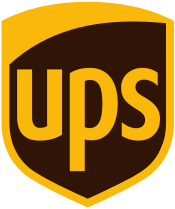
With UPS OnLine® Tools, customers can get real-time shipping rates to domestic U.S., Canadian, and international addresses. Your customers can also view UPS tracking information for their packages right from your store! You can enable UPS OnLine® Tools by entering your account information within AbleCommerce. This allows you to begin testing real-time shipping rates without a UPS account.
The AbleCommerce integration with UPS Online® Tools includes the UPS Rates & Service Selection Tool and the UPS Tracking Tool. The AbleCommerce UPS integration includes features like selecting your rate based on customer type, including insurance, and package tracking. AbleCommerce uses your product's weight and dimensions to calculate the most accurate rates possible.
International shipping is available from many locations –
Argentina, Australia, Austria, Belgium, Brazil, Canada, Chile, Costa Rica, Denmark, Dominican Republic, Finland, France, Germany, Greece, Guatemala, Hong Kong, India, Ireland, Israel, Italy, Japan, Luxembourg, Malaysia, Mexico, The Netherlands, New Zealand, Norway, Panama, Peru, Philippines, Portugal, Puerto Rico, Singapore, South Africa, South Korea, Spain, Sweden, Switzerland, United Kingdom, United States, U.S. Virgin Islands, and Venezuela.
UPS Online® Tools Features and Requirements
UPS Online® Tools requires you to register online through AbleCommerce. Providing a shipping account number is optional.
UPS expects all product measurements to be in pounds and inches. Rates will still be calculated if you use a different unit of measurement, but there is additional overhead in converting the measurements. You will have the best performance if you use pounds and inches to begin with.
Shipping to international destinations is available.
Shipment tracking features are built-into AbleCommerce. Tracking services are provided by UPS Online® Tools.
Printing Labels with automated tracking number retrieval.
Address Verification Services.
Negotiated (discounted) business rates.
Installing the UPS Plug-in for AbleCommerce
Login to your AbleCommerce installation.
Using the menu, go to the Plugins page.
Use the Filter Plugins option and select the type "Shipping".
Note: UPS plugin will be available in the list as shown in the screenshot below.

Click the green Install button in the far right column.
When the confirmation popup appears, click the green Yes, install it button.
Upon completion, click the orange Configure button.
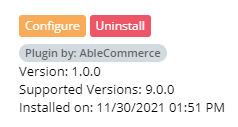
NOTE: Version shown may be different depending on the release of AbleCommerce you are using.
Register with UPS®
In order to use UPS OnLine® Tools you must have an active account with them.
After installing, go to the Configure > Shipping > Carriers page from the admin menu.
Any installed shipping carriers will be available from this page. Click the blue plus (+) button or linked name to continue to the registration page.

Carefully read the on-screen instructions before continuing.If you don't have an existing account, register with UPS at https://www.ups.com/one-to-one/register
Once registered, you should receive an email containing the information needed to complete this registration.
Make sure your account has been activated by UPS and then enter your UPS User ID and Password in the fields provided.
Also enter the Access Key and your UPS Account Number into the fields provided.
Click the Next button to continue, or CANCEL to quit and return to the previous menu.
After completing the short registration process, you will be on the Configure USPS® page as shown in the next section.
Configure UPS Online® Tools
You must use a warehouse with an address supported from the UPS account.
From Configure > Shipping > Carriers page, click the EDIT icon for UPS. This will bring you to the Configuration page.

The UPS User ID, Password, Access Key and Account Number previously entered are shown in the first four fields. These elements identify your UPS Online Tools account.
Note: The UPS Account Number is necessary if you wish to offer negotiated (discounted) shipping rates or the print labels feature.Review and choose the appropriate Customer Type which should match your UPS account. This type of shipping determines which rates will be shown to your customers. An incorrect setting for Customer Type will result in less accurate rate estimates.
Note: You must contact UPS and make sure your account is configured for negotiated rates.If you have an established an account with UPS, you can use the printing label feature to generate tracking numbers and labels. Check the box next to Enable Printing of Labels.
The Optional Insurance option can include shipping insurance with the shipping amounts. When enabled, all real-time rates will reflect the additional cost (if any) for insurance. If you want the estimated rate to include insurance, check the bo for it. When this option is checked, AbleCommerce sends the value of the shipment to the service rate provider. Most shipping services already provide insurance up to a certain amount. The default setting is 'No', or unchecked.
The Enable Package Breakup option is checked by default. This allows a shipment to be split into multiple parts if the total order weight exceeds the maximum amount. This will not change the number of shipments in the order, only the calculation to determine the most accurate shipping costs.
The Maximum Weight is this carriers limit for a package. The default value is 150 lbs.
The Minimum Weight is the amount used when the order weight does not meet the minimum.
Enable Address Validation is an optional service that can be used when a customer enters an address during checkout. If a better address can be suggested to the customer, they will see an alternate address and be allowed to use the suggested one, or keep the address as entered. Check the box to enable this feature.
- For UPS, you will need to have your account enabled for this feature, and you can only use it in conjunction with UPS shipping services.
- You may not use UPS for Address Validation while using a different provider for shipping rates.
- You should not activate more than one Address Validation Service within AbleCommerce.The URL settings come pre-configured when you create the shipping account through AbleCommerce. These URL's can change so the fields are available for modification. It is not advisable to modify the URL's here unless specifically instructed to do so.
Address Service Test URL: The URL to which requests are posted in Test mode.
Address Service Live URL: The URL to which requests are posted in Live mode.
Rating URL: The URL to which requests are posted in Live mode.
Test Server URL: The URL to which requests are posted in Test Mode.
Tracking URL: The URL to which requests are sent for package tracking. {0} is substituted with the tracking number at the time of request.The Mode settings are used to enable/disable rates from the test server. Debugging can also be enabled which can help with any communication problems.
Test Mode: When Test Mode is enabled, rate requests are sent to test server using the Test Mode URL.
Debug Mode: When debug mode is enabled, all messages sent to and received from UPS are logged. This should only be enabled at the direction of qualified support personnel.
Default Log File Location: ..\App_Data\Logs\[gatewayname].logAfter making any changes, click the SAVE button. To complete the shipping carrier setup, see Adding or Removing Shipping Methods in the next section.
Or, you can click the SAVE AND CLOSE button to return to the Shipping Carriers page.
Adding or Removing Shipping Methods
Configuring Shipping Services for UPS Online® Tools
You must select the services you want to be available to your customers. Each service (shipping method) is configured separately once it's added.
In the bottom section of the page, you will see the Shipping Method menu. This is a list of all services offered by the provider. You should review the entire list of shipping services offered and decide which ones you want to make available as shipping options in your store.
You can use the buttons from the Action column to individually Add or Edit the shipping method.
Check the box next to one or more shipping methods, or check the box at the top of the first column to quickly select all methods.
This will activate the Update button, which will drop-down to provide 2 options: either Add or Remove the selected methods.
The update will take place immediately after selection.

In this example, we will add and configure the "UPS Ground" service. Check the box next to all others you want to offer as a shipping service.
Using the Update button, select the option Add selected methods.
The selected shipping services now appear at the top of the list and each will be linked for configuration.
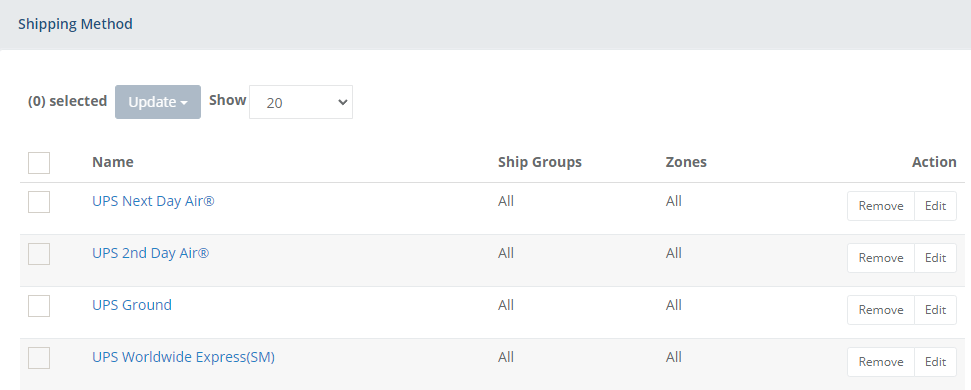
To remove an individual shipping method, use the Remove button in the Action column, or you can select multiple methods by checking the box in the first column and activating the Update button which will give you the option to select Remove selected methods. The update will take place immediately after selection.
Configure a Shipping Method
Each shipping method will use its own configuration settings. To configure a shipping service, click the EDIT button to view the Configure page.

The above example shows the default configuration values for all shipping services that are added.
Change the Shipping Method Name if needed. This is the name that will be displayed to the customer and the merchant on all invoices and receipts.
Note: Most third-party carriers do not want the names of their shipping methods changed.If these shipping charges are taxable, then select a Shipping Tax Code. Make sure you understand the tax laws according to your local tax authority.
Taxes on shipping charges are combined with any other taxes calculated for the shipment.Use the Handling Fee field to include a charge for handling or processing. The handling fee can be a fixed amount, percent of the shipping charge, or a percentage of the shipment total. After entering the amount, select one of these three options available.
There is a display option to either show the Handing Fee included in the shipping cost, which will hide the amount in the shipping cost. Or to show the handling fee separately, where it will be displayed as a separate line item on the invoice. If you show the handling fee separately, you may then select a Handling Tax Code if you are required to collect tax on this type of charge.
The Minimum Purchase field is the designated minimum value of a shipment before this shipping method will be available. Until this limit is met, the shipping method will not display.
A minimum purchase value applies to the total of each shipment, not the total of the order.The Maximum Purchase field is the designated maximum value of a shipment before this shipping method will be available. If this limit is exceeded, the shipping method will not display.
A maximum purchase value applies to the total of each shipment, not the total of the order.When finished making changes, be sure to Save.
Additional Settings
There are three optional configurations which can be used to filter shipping methods that are shown to the customer.
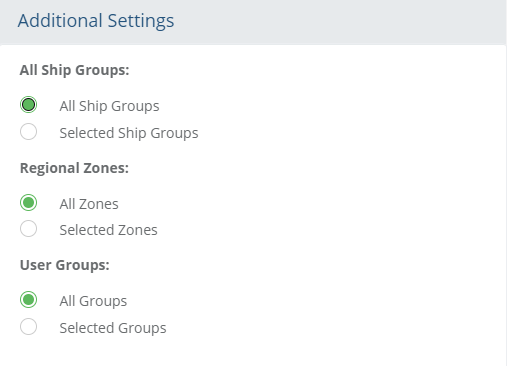
These additional settings allow you to display available shipping methods according to the shipping groups (used for custom shipping conditions and locations where products are shipped from), the zones (regions the products are shipped to), and/or any groups that a customer is assigned to. By default, every new method added will use all available destinations, special shipping conditions, and user groups. To make shipping methods explicit to any of these criteria, follow the steps given below.
Shipping with Ship Groups
Ship Groups are typically used for products that have special shipping requirements, such as perishables, oversized, or overweight. You can also define the shipping origin.
To setup Ship Groups, go to Configure > Shipping > Ship Groups using the menu.
If this shipping service needs to be applied to a specific warehouse(s), then you will need to setup Ship Groups first. The warehouse determines the origin of shipping, and ship groups allows you to choose specific warehouses and define which shipping methods and products will be available to them.
A warehouse determines the shipping origin.
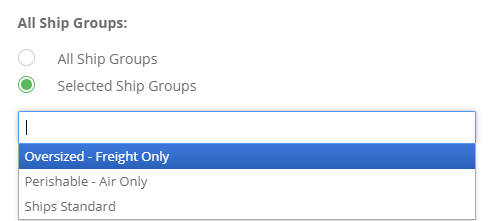
If this shipping method will be allowed from all locations and types, then keep the default All Ship Groups option selected.
Shipping with Zones
Zones allow you to configure specific places for use with many features, including shipping methods.
To setup Zones, go to Configure > Regions > Zones using the menu.
If the shipping service applies to a specific Zone(s), select it from the Selected Zones list.
A zone determines the shipping destination.
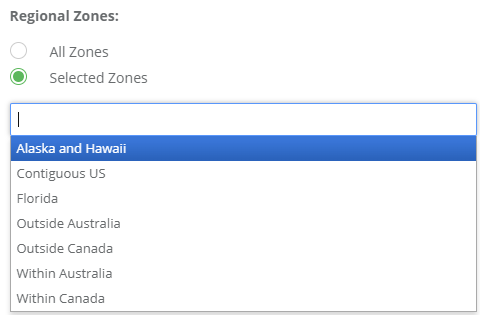
If the shipping service applies to all ship to locations, then keep the default All Zones option selected.
Shipping with User Groups
When you apply a shipping service to a user group, then it will only appear for the users who are logged in as members of that group.
To setup User Groups, go to People > Users > User Groups for regular customers. To setup User Groups for administrators only, go to People > Admins > Admin Groups.
If the shipping service applies to a specific User Group or Admin Group, select it from the Selected Groups list.
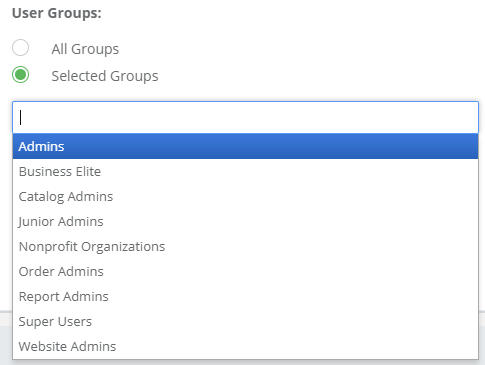
If the shipping service applies to everyone, admin and customers alike, then keep the default All Groups option selected.
When finished configuring this shipping method, press the Save button to continue.
Configuring Additional Services for UPS Online® Tools
At the bottom of the Configure Shipping Carrier page, there will be a list of service names for the selected carrier.

When finished configuring a shipping method service, you may want to Save and then select another service type to configure.
After you have completed all configurations, press the Save and Close button to return to the list of all methods. This will include all shipping methods for all carriers any custom methods you have created.
This will bring you back to the Shipping Methods page which displays all configured shipping service types available for the store.
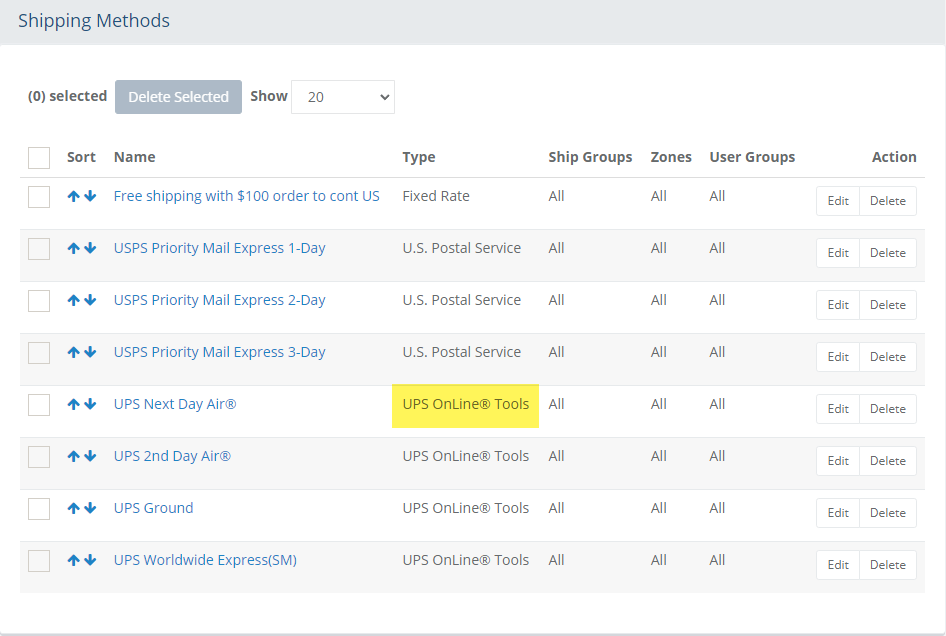
The Type column displays the shipping service and any custom methods in place.
Additional columns are shown for Ship Groups, Zones, and User Groups. Each of these features are documented separately.
From this page, you can add, sort, remove and configure all shipping methods.
To add a new shipping carrier, go to the Plugins page using the menu. You may have as many services and combinations of shipping carriers as needed.
Troubleshooting Techniques
Use this quick guide if the shipping methods are not appearing during the checkout process.
Confirm your product(s) are shippable and have a weight. Some carriers require dimensions as well. This information is found within the Shipping and Tax section of the Edit Product page.
Confirm you warehouse (the shipping origin) has a valid address for the carrier. Go to Configure > Shipping > Warehouses to check address information. On the same page, you will be able to find all the products assigned to this warehouse.
Confirm you are shipping to a valid address for the method. For example, some shipping methods will only appear if they are within a particular country or state. Another example, ground transportation is not available to Hawaii from the mainland United States.
If the carrier requires an account number or key, confirm the information is correct from the applicable service carrier's configuration page. This information is found under the Configure > Shipping > Carriers page.
Check the available shipping services you have configured and make certain they have the correct ship groups or zones defined for the package and address delivery. This step applies if you have configured special shipping situations using Ship Groups and/or Zones.
From the configuration page of the carrier, there is a checkbox to enable Debug Mode. Only use this feature if all steps above have been confirmed. Once debug is enabled, test a shipment calculation through the checkout process. This will log an entry.
Then you will need to access the debug log file which is located on the server in the following location ...\website\App_Data\logs\*carrier name*.log
Open the file and carefully review the data that was SENT and RECEIVED. In the received response, there should be a message or error indicating the reason the shipping method did not calculate on the shipment received. If needed, provide this information to technical support.
When finished troubleshooting, make sure to turn OFF debug mode.
Successful Shipping Rates
When the shipping carrier is setup correctly, the user should see the selected shipping methods and rates on the /Checkout/ShipMethod page:

UPS brand, and the Color Brown are trademarks of United Parcel Service of America, Inc. All Rights Reserved.